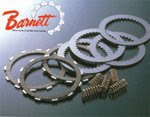Ok, did u enjoy the video? Everything is clear for you? Haha. Ok, let me describe in a long+detailed description. Firstly let me inform all of you that clutch is a term referring to a mechanism for transmitting rotation. This rotation can be either engaged or disen gaged. When the clutch is engaged, there is no pressure on the lever. On the other hand, pulling the lever back towards you will disengage the clutch plates. Doing this will allow you to shift gears.
gaged. When the clutch is engaged, there is no pressure on the lever. On the other hand, pulling the lever back towards you will disengage the clutch plates. Doing this will allow you to shift gears.
Basically, clutch is popular as it is a subcomponent of a motor vehicle. On motorcycles, the clutch is operated by the clutch lever, located on the left handlebar. From idle, the engine speed will increase while engaging. Raising your engine speed too high will cause excessive clutch plate wear and cause a harsh, jerky start. This type of start is used in drag racing and other competitions. Clutch accessories work together to attain the desired starting performance of your motorcycle bike. On the left-hand handlebar grip, your bike lever clutch is positioned. The engine and transmission is disconnected as you pull the clutch lever toward you. By doing so, you allow easily shift gears. Clutch lever is connected to a cable which goes to the physical clutch release mechanism. It can also be hydraulically operated. Broken clutch cables are eliminated by the use of a hydraulic clutch.
Friction p lates are the major working components of a motorcycle clutch. They take the abuse and wear of daily riding and since they are built as a consumable item, they wear out and need to be replaced. You can do things in order to extend the life of your clutch. Topping the list is to make sure all clutch accessories and components are properly positioned or adjusted. Maintaining proper lubrication of your wet clutch is also necessary. Oil in a wet clutch functions as a coolant. The oil in the primary chain case flows around the clutch plates and friction plates. You should change clutch oil as often as necessary by using quality oil at the proper viscosity. To minimize excessive slipping, you will need to adjust your riding style. This is because over slipping can cause too much heat resulting in rapid wear. Should the clutch components become weak, replace them with the best clutch parts available in the motorcycle store near you. Choosing high quality clutch accessories or components will definitely save money in the long run.
lates are the major working components of a motorcycle clutch. They take the abuse and wear of daily riding and since they are built as a consumable item, they wear out and need to be replaced. You can do things in order to extend the life of your clutch. Topping the list is to make sure all clutch accessories and components are properly positioned or adjusted. Maintaining proper lubrication of your wet clutch is also necessary. Oil in a wet clutch functions as a coolant. The oil in the primary chain case flows around the clutch plates and friction plates. You should change clutch oil as often as necessary by using quality oil at the proper viscosity. To minimize excessive slipping, you will need to adjust your riding style. This is because over slipping can cause too much heat resulting in rapid wear. Should the clutch components become weak, replace them with the best clutch parts available in the motorcycle store near you. Choosing high quality clutch accessories or components will definitely save money in the long run.
Lastly I want to remind that a good caring for clutch is indeed so it'll work well. Don't forget that clutch is a part of big factor to make sure your motorcycle "pick-up" at the start as you pull the throttle. Hope this article benefit you. Till then.. Vroooooooooom!!!








